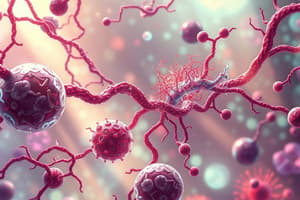Podcast
Questions and Answers
What is the primary function of ATP in muscle contraction?
What is the primary function of ATP in muscle contraction?
- To synthesize proteins in muscle cells
- To provide energy for the movement of muscle fibers (correct)
- To release neurotransmitters at the synapse
- To regulate the electrochemical gradient across the muscle cell membrane
What is the role of ATP in nerve impulse transmission?
What is the role of ATP in nerve impulse transmission?
- To release energy for the synthesis of nucleic acids
- To pump sodium and potassium ions across the membrane (correct)
- To synthesize proteins in nerve cells
- To regulate the muscle contraction
What is the result of ATP breakdown into ADP and inorganic phosphate?
What is the result of ATP breakdown into ADP and inorganic phosphate?
- Energy is stored for later use
- Proteins are synthesized
- Energy is released for cellular processes (correct)
- Muscle contraction is regulated
What is the function of ATP in biosynthesis?
What is the function of ATP in biosynthesis?
What is ATP composed of?
What is ATP composed of?
Why is ATP often referred to as the 'energy currency' of the cell?
Why is ATP often referred to as the 'energy currency' of the cell?
Flashcards are hidden until you start studying
Study Notes
ATP: The Energy Currency of the Cell
- ATP is the primary energy source for cellular processes in living organisms, providing energy for various biological functions.
- ATP is composed of an adenine base, a ribose sugar, and three phosphate groups.
- When ATP is broken down into ADP and inorganic phosphate, energy is released that can be used by the cell.
Role of ATP in Muscle Contraction
- ATP is required to power the movement of muscle fibers, enabling muscle contraction.
- ATP binds to myosin, a protein found in muscle cells, and provides the energy needed for movement along actin filaments.
- Without ATP, muscles would not be able to contract and movement would be impossible.
Role of ATP in Nerve Impulse Transmission
- ATP maintains the electrochemical gradient across the cell membrane, enabling nerve impulse transmission.
- ATP is needed to pump sodium and potassium ions across the membrane, creating an action potential.
- ATP is required for the release of neurotransmitters at the synapse, allowing for communication between nerve cells.
Role of ATP in Biosynthesis
- ATP is used as a source of energy for the synthesis of macromolecules such as proteins, nucleic acids, and lipids.
- ATP provides the energy needed to drive the various chemical reactions required for the production of these molecules.
- Without ATP, cells would not be able to grow, repair damage, or reproduce.
Importance of ATP
- ATP plays a central role in a wide range of biological processes.
- ATP is essential for muscle contraction, nerve impulse transmission, and biosynthesis.
- Without ATP, cells would not be able to function properly, and life as we know it would not be possible.
Studying That Suits You
Use AI to generate personalized quizzes and flashcards to suit your learning preferences.



